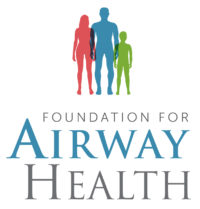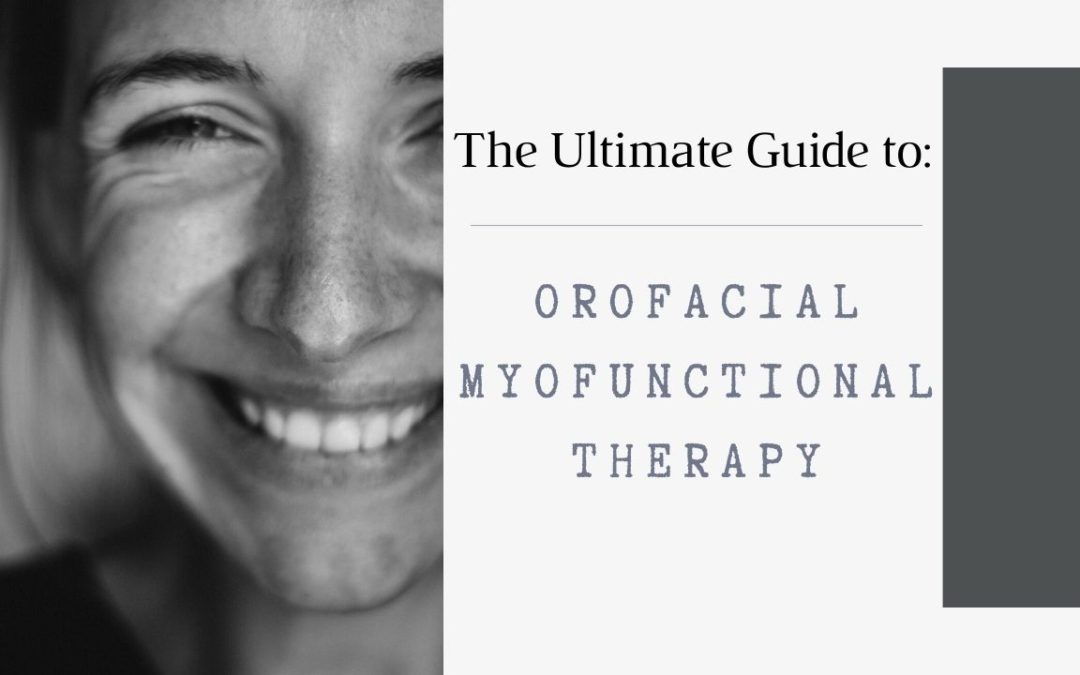After years of answering the same common and extremely important questions, the Ultimate Guide to Orofacial Myofunctional Therapy was drafted to put all of the frequently asked questions about orofacial myofunctional therapy into one location. Throughout the Ultimate Guide to Orofacial Myofunctional Therapy, you will also find the links to some of our other ultimate guides, as well as some very popular content to support your myofunctional learning.
What is Orofacial Myofunctional Therapy?
Orofacial myofunctional therapy is an individualized program of static and dynamic strength and pattern retraining exercises of the tongue and orofacial muscles intended to correct maladaptive oral habits and help restore correct oral resting posture.
This therapy goes by several different names: orofacial myology, myofunctional therapy, and orofacial myofunctional therapy. This therapy is completed by therapists trained to treat disorders of the face, mouth, and neck muscles. Believe it or not, the muscles all form an intricate network and are designed to function a certain way. However, the body is amazing at adapting when there is a problem, resulting in dysfunction of these muscle groups. This adaptation can result in lifelong consequences and an increase in symptoms over time.
Myofunctional therapy, as it is most commonly called, works to bring awareness to the areas of concern and then helps teach the patient how to properly use the muscles, implement new habits, and how to retain those new patterns.
Myofunctional therapy focuses on the muscles of the mouth, face, and throat. By strengthening weak muscles, learning proper function, and making behavior modifications, improvements can be made to breathing, speaking, chewing, and swallowing.
Read Understanding the Intricate Muscles of the Tongue
What are Orofacial Myofunctional Disorders (OMD)?
Orofacial myofunctional disorders are disorders of the muscles and the functions of the face and mouth. These disorders may affect breastfeeding, chewing, swallowing, speech, jaw movement, facial and skeletal growth, malocclusion, orthodontic treatment, oral hygiene, facial appearance, and more.
The goals for myofunctional therapy are detailed below, but in a nutshell, anyone who has difficulty with one or more of the goals of myofunctional therapy indeed has an OMD.
Goals for myofunctional therapy
- Correct tongue posture (the tongue should live “tip to tail” in the roof of the mouth)
- Correct mouth posture (mouth should be closed, teeth slightly apart, and lips sealed)
- Correct nasal breathing
- Correct swallow mechanics
These goals are achieved through adequate myofunctional therapy.
Correct Tongue Posture
A low resting tongue posture can contribute to incorrect muscle function. This may be the result of a habit or a physical barrier, such as a tongue-tie. It definitely has a domino-like effect. When the tongue resting posture is low, it can lead to airway obstruction. When someone has difficulty getting air, the body responds to this “911” emergency call by opening the mouth and shifting the tongue forward to open up the airway and allow more air in. Quite often, this temporary mouth breathing situation leads to a chronic habit of open-mouth breathing.
Incorrect tongue resting posture is most concerning because of the constant, static force of the tongue at rest. This constant pressure is more of a concern than the intermittent forces of an incorrect swallowing pattern (tongue thrust detailed below).
When it comes to children, correct oral rest posture and continuous nasal breathing is absolutely critical for sufficient craniofacial and airway development.
Low tongue rest posture also causes jaw pain in many people. The temporomandibular joint (TMJ) is the most complex joint in the body, and myofunctional therapists understand the importance of correct tongue position when it comes to keeping this joint healthy. Tongue position is crucial because it helps stabilize the jaw. When the tongue is low, it shifts the condyle forward leaving the jaw destabilized, and causing pain and headaches for many people.
Correct Mouth Posture
Correct mouth posture is considered to be mouth closed, teeth gently together, and lips sealed. Incorrect mouth posture can lead to changes in how the face looks.
In addition, open mouth rest posture can lead to an open bite. An open bite is a condition where the teeth can no longer touch together, to bite into a sandwich, for example. When the molars are chronically separated, the teeth like to continue erupting in search of a partner to occlude with. This process, called supereruption, can lead to teeth that no longer touch.
Correct Nasal Breathing
For optimum health and high, level performance, your body relies on nasal breathing. When a person is mouth breathing, not only does it alter the correct development of the facial skeleton and the airway, but mouth breathing also deprives the body of important oxygen needed to function properly. Mouth breathing also causes the body to live in a chronically, stressed state of sympathetic overdrive.
When a person is mouth breathing, the body is constantly in “fight or flight mode” resulting in shallow, rapid breathing and poor use of the diaphragm muscle. This shallow, thoracic breathing affects the sympathetic and parasympathetic nervous system balance, the balance of oxygen and carbon dioxide in the body, as well as robs the body of the benefits of the warm, moist, and humidified air that has passed through the nasal passages.
Read The Ultimate Guide to Breathing
Correct Swallowing Mechanics
Correct swallowing mechanics can be the hardest part of therapy. Lack of correct nasal breathing or correct oral rest posture can cause the tongue to thrust when swallowing. This thrust is an adaptation or compensation of the body. A tongue thrust can occur anteriorly (pushing forward), laterally (pushing sideways) and can occur on just one side (unilaterally), or on both sides (bilaterally).
One important fact about tongue thrusts, and one that surprises many practitioners, is that a tongue thrust is not the problem. It is a symptom of a bigger problem lurking beneath the surface. The bigger problem is incorrect oral rest posture. The good news is that a tongue thrust is one of the easiest ways for a myofunctional therapist to spot an orofacial myofunctional disorder.
Another reason that swallowing impairments can be so hard to correct is that many people do not consider or understand the different stages of swallowing and how oral rest posture is related. There are 4 stages of swallowing and each stage requires certain actions before the next stage can be completed. If the tongue and mouth posture is incorrect, or the tongue can’t elevate to create an intraoral suction (due to a tongue-tie, muscle impairment, or inability to nasal breathe) then an adaptation must develop.
This is why it is so important to understand why a person has a tongue thrust, not just attempt to fix it.
Read How Myofunctional Therapy and Incorrect Swallowing are Connected.
How does all of this affect the craniofacial development?
Once a person understands how this stuff all ties together, it becomes much easier to understand how the craniofacial development can be altered with an OMD.
Tongue posture
When a person has a low, postured tongue, whether it is from a tongue-tie, weak muscles, poor habits, or all three, the tongue has not been used as nature’s palatal expander. When the tongue is up where it is supposed to be, it helps spread the maxilla out, creating a spacious upper arch (with plenty of room for all teeth to erupt) and a lower palatal ceiling. When the tongue doesn’t get to do its job, the result is a high, narrow palate, insufficient forward growth of the facial skeleton, tooth crowding, a recessed mandible, and inadequate airway space.
Chewing
When a person does not chew adequately, cannot chew well or avoids harder to chew foods, craniofacial growth is affected. Whether this is because of a tongue-tie or muscular impairment, lack of adequate chewing can stunt the growth of the facial bones. Encouraging chewing is an excellent way to encourage sufficient craniofacial growth.
Breathing
When a person is mouth breathing, usually the “rules” of correct tongue and mouth posture are broken. This altered position of the tongue and mouth affects the oral function of the muscles, as well as the sufficient development of the face. Facial aesthetics are affected as the face grows long and narrow, often with a sharp vertical jawline, flat cheeks, and low facial tone. These consequences of mouth breathing can last a lifetime, not to mention it takes a toll on self-confidence as well.
How do I know if I need myofunctional therapy?
The detailed information above should give plenty of clues about whether or not a person has concerns. If any one of the goals detailed above cannot be accomplished, it is time to pursue myofunctional therapy. The sooner that this therapy is completed, the sooner the dysfunction present can be addressed and corrected.
Who is myofunctional therapy for?
Myofunctional therapy is for all ages.
When it comes to younger ages, it is important to address myofunctional impairments sooner rather than later because of the time-sensitive window regarding a child’s craniofacial development. The facial development of a child is mostly complete by age 10-12, so waiting can mean possible permanent consequences.
Adults can achieve great success with therapy at any age, but again, the sooner the better. It is often disappointing to adults who successfully complete therapy and experience life-changing results, that therapy wasn’t done sooner.
Benefits of myofunctional therapy
Myofunctional therapy is an affordable, low risk, non-invasive option to drastically improve wellness, breathing, chewing, swallowing, digestion, mood, sleep, motivation, and self-esteem.
Myofunctional therapy may benefit people who experience:
- Choking
- Digestive issues (Visit our Swallowing & Digestive Issues page)
- Anxiety
- Erectile dysfunction
- Mouth breathing
- Snoring or sleep apnea (Visit our Sleep page)
- Chronic fatigue
- Chronic pain
- Toxic oral habits
- TMJ pain
- Acid reflux or heartburn
- Headaches
- Posture concerns
- Weight management issues
- Speech concerns
- Stomach aches
Where do I find a myofunctional therapist?
This specialized therapy means that you may not find a myofunctional therapist in your town. That is ok! After all, it is a new decade, and teletherapy is alive and well (especially in the wake of the Covid-19 pandemic). In today’s fast pace not everyone has the time nor want to travel for an appointment, especially in metropolitan areas where traffic can be a nightmare! Myofunctional therapy is a therapy that can be done just as effectively online, as it can be in person. It is important to find someone who you like and trust when looking for a myofunctional therapist. Not everyone is a personality match, so it is important for you to be comfortable.
Who can be a myofunctional therapist?
There are a few different occupations that have myofunctional therapy listed in the scope of practice. This includes dentists, registered dental hygienists, and speech therapists. Some specialized medical practitioners, such as occupational therapists, physical therapists and chiropractors are implementing some myofunctional therapy components to their practice
Is myofunctional therapy just tongue exercises?
No, myofunctional therapy helps strengthen the tongue and orofacial muscles, develop coordination, create new neuromuscular connections, improve breathing, balance mood, and build positive, lifelong habits.
How much will myofunctional therapy cost?
This price will vary depending upon the expertise of the therapist, location, client needs, length, and delivery of the program. A new, inexperienced therapist will likely charge less than an experienced pro who has built authority in the field. It is important not to let decisions regarding myofunctional therapy be based only on price. It is important to consider expertise, practice philosophy, therapy framework, and what uniquely sets the therapist apart from the rest.
What Should You Do First?
Drop into the rabbit hole! C’mon in, the water is fine! Once you start to understand this stuff, you will become obsessed with the information, just like we have! Continue learning.
If you’re new to all this myofunctional therapy stuff, you would certainly benefit from reading our most popular content.
Read The Ultimate Guide to tongue-Ties
Read The Ultimate Guide to Sleep Disordered Breathing
Read Tongue-Ties and Myofunctional Therapy: 2 Pieces Of the Puzzle
Free Learning Resources





Meet Carmen Woodland
I found this path of passion years ago as a dental hygienist. After a stint in graduate school to earn my M.B.A., I decided that I needed to pivot. My heart was no longer in scraping teeth, but making a much bigger impact on lives touched by myofunctional impairment.
My story is personal and close to home. My sweet granddaughter was passed back and forth amongst doctors and therapists for years trying to figure out her speech, breathing, sleep, chewing and swallowing issues. It wasn’t until I completed more training that I knew her problem was a significant tongue-tie. Bingo.
Fast forward to now. I’m a crusader. A warrior. A voice for those who can’t find theirs, or who don’t have one.
I left clinical hygiene practice to start Integrative Myofunctional Therapy. It has evolved from a way to make a living, into an obsession!
I see clients all over the world and provide innovative, virtual therapy in the remotest of places.
In addition, I also
- Teach other dental hygienists how to become myofunctional therapists through my Myo Mastery Program
- Coach dental offices on how to implement myofunctional screening into the daily practice
- Speak in various settings
I’m an airway provider for the Foundation of Airway Health, where I work diligently for the recognition, diagnosis, and treatment of airway related disorders.
And last but not least, I’m a proud member of several professional associations that afford me the opportunity to learn so that I can help you. My professional memberships include:
How To Work With Carmen Woodland
The best place to start is with a free mini-assessment. This gives you the chance to meet me, get your questions answered, and make sure it makes sense to move on to a paid exam. You can schedule a free visit me right here.
Make sure you download your Getting Started Guide also!





